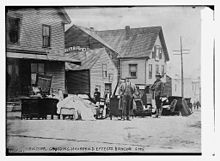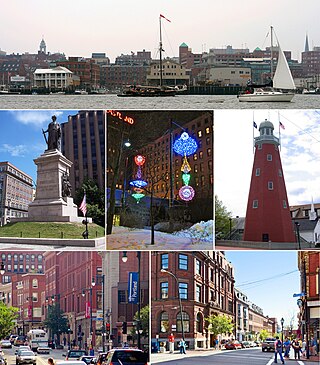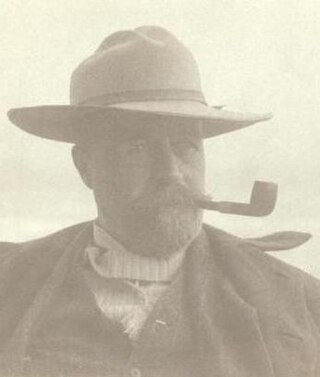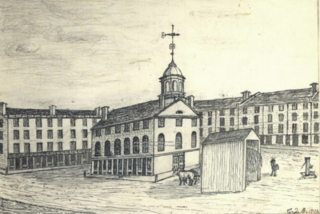


The Great Fire of 1911 took place in Bangor, Maine, United States, on April 30 and May 1, 1911. A small fire that started in a downtown shed went out of control and destroyed hundreds of commercial and residential buildings.



The Great Fire of 1911 took place in Bangor, Maine, United States, on April 30 and May 1, 1911. A small fire that started in a downtown shed went out of control and destroyed hundreds of commercial and residential buildings.
It started in the afternoon of April 30, 1911, on Broad Street. High winds had spread it to a shed on Exchange Street and the Universalist Church on Center Street by 4:10 PM, from where it spread into the residential neighborhood on Center Street Hill. In 1907, the National Board of Fire Underwriters had mapped the fire geography of Bangor, and predicted that a large fire could have spread from that area. [1]
The fire eventually became so large that the glow in the sky could be seen in Belfast. It was brought under control on Monday morning, May 1, 1911, but before it was out, it destroyed much of Downtown Bangor. The Post Office, the Custom House, and Norumbega Hall were lost, along with the three buildings of Bangor High School and the Bangor Public Library. Somehow, City Hall survived, despite being in the direct path of the fire. The library's collection of 70,000 volumes was destroyed, along with much of the Bangor Historical Society's collection. An attempt to slow the fire by dynamiting buildings in its path failed. A light rain that began overnight did much to bring the fire under control. [2] In total, 285 residences, 100 businesses, and 6 churches were destroyed, doing $3.2 million damage and leaving hundreds homeless. [3] [4] Before the fire, insurance companies had considered Bangor a good risk.[ citation needed ]
Remarkably, only two people died: one Brewer man who was caught in electrical wiring while crossing a bridge, and one firefighter. [5]
Fire crews were called from as far away as Lewiston and Portland. After the telephone company caught fire, the wire chief climbed a pole and cut in on a trunk line to make aid calls. [6] One team that was sent up from Boston, Massachusetts, ended up fighting a fire in Portland when their train stopped there. [7]
The area destroyed by the fire was quickly rebuilt, with many architectural commissions going to New York and Boston firms (such as Carrere and Hastings and Peabody and Stearns), as well as local designers Wilfred E. Mansur, C. Parker Crowell, and Victor Hodgins. A large portion of the rebuilt area (43 buildings) was listed on the National Register of Historic Places in 1984 as the Great Fire of 1911 Historic District.

Portland is the most populous city in the U.S. state of Maine and the county seat of Cumberland County. Portland's population was 68,408 in April 2020. The Greater Portland metropolitan area has a population of approximately 550,000 people. Historically tied to commercial shipping, the marine economy, and light industry, Portland's economy in the 21st century relies mostly on the service sector. The Port of Portland is the second-largest tonnage seaport in the New England area as of 2019.

Bangor is a city in and the county seat of Penobscot County, Maine, United States. The city proper has a population of 31,753, making it the state's third-most populous city, behind Portland (68,408) and Lewiston (37,121). Bangor is known as the "Queen City."

Old Town is a city in Penobscot County, Maine, United States. The population was 7,431 at the 2020 census. The city's developed area is chiefly located on the relatively large Marsh Island, but its boundaries extend beyond it. The island is surrounded and defined by the Penobscot River to the east and the Stillwater River to the west.

The University of Southern Maine (USM) is a public university with campuses in Portland, Gorham and Lewiston, Maine, United States. It is the southernmost of the University of Maine System. It was founded as two separate state universities, Gorham Normal School and Portland University. The two universities, later known as Gorham State College and the University of Maine at Portland, were combined in 1970 to help streamline the public university system in Maine and eventually expanded by adding the Lewiston campus in 1988.

The Bangor Auditorium was a 5,948-seat multi-purpose arena located in downtown Bangor, Maine.

Northeast Harbor is a village on Mount Desert Island, located in the town of Mount Desert in Hancock County, Maine, United States.

John Calvin Stevens was an American architect who worked in the Shingle Style, in which he was a major innovator, and the Colonial Revival style. He designed more than 1,000 buildings in the state of Maine.

The Valentine Phantom, often referred to as the Valentine Bandit in media reports, refers to an unidentified individual or group who each Valentine's Day secretly decorate the downtown area of a city in the United States with a series of red hearts printed on sheets of letter-sized paper.
Bangor High School, a member of the Bangor School System, is a high school in Bangor, Maine, United States. It has an enrollment of approximately 1,500 students in grades 9–12.

The Bangor Public Library is the public library of Bangor, Maine. It shares the URSUS online cataloging system with the University of Maine and other Maine libraries.

The History of Portland, Maine, begins when Native Americans originally called the Portland peninsula Məkíhkanək meaning "At the fish hook" in Penobscot and Machigonne in Algonquian. The peninsula and surrounding areas were home to members of the Algonquian-speaking Aucocisco branch of the Eastern Abenaki tribe, who died largely due to the introduction of foreign illnesses during colonization. Some were forcibly relocated to current day New Hampshire and Canada during European settlement.
There are a number of wind power projects in the state of Maine, totaling more than 900 megawatts (MW) in capacity. In 2020 they were responsible for 24% of in-state electricity production. In 2019, Maine had more wind capacity than the other five New England states combined, at 923 MW.

St. John's Catholic Church is a historic church at 217 York Street in Bangor, Maine. Built in 1855 at the height of the anti-immigrant Know Nothing movement, it stands as a major symbol of the city's Irish-American heritage, and a high quality local example of Gothic Revival architecture. It was listed on the National Register of Historic Places in 1973.

The Great Fire of 1911 Historic District is located in downtown Bangor, Maine, and has been listed on the National Register of Historic Places since 1984. It preserves Maine's most significant collection of early 20th century public and commercial buildings, and commemorates an urban re-building campaign matched only by Portland's following its own destruction by fire in 1866. The Great Fire of 1911 was Maine's last large-scale urban conflagrations, but resulted in the creation of an early 20th-century urban space relatively unique in Maine or northern New England.
Wilfred E. Mansur (1855–1921) was the most prominent architect in late 19th and early 20th century Bangor, Maine.

C. Parker Crowell (1876–1959) was an American architect in practice in Bangor, Maine, from 1902 until his retirement in 1956. Crowell and his firm would design over 1000 buildings in the course of his career. The firm Crowell co-founded is still in business as WBRC.

The Graham Building is a yellow-brick Romanesque Revival style commercial building in downtown Bangor, Maine, at the corner of Harlow and Central Streets. It is one of the most prominent buildings in the Great Fire of 1911 Historic District, which is listed on the National Register of Historic Places.

Great Northern Paper Company was a Maine-based pulp and paper manufacturer that at its peak in the 1970s and 1980s operated mills in Arkansas, Georgia, Maine, and Wisconsin and produced 16.4% of the newsprint made in the United States. It was also one of the largest landowners in the state of Maine.

The Asticou Inn is an inn in Northeast Harbor, Maine. It was built in 1883. In 1899, it was destroyed by fire and rebuilt over the course of two years.

On the morning of March 29, 1911, a fire destroyed substantial portions of the New York State Capitol, including vast holdings of the New York State Library and the New York State Museum. It destroyed or damaged hundreds of thousands of documents and books. There was one casualty, Samuel Abbott, a watchman.